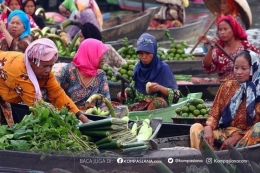Indonesian youth are probably the most collectivist youth in whole Asia. Despite the current penetration and adoption of mobile as well as social media. We could still see the young people relying on face to face interaction on their daily activities. This daily face to face routine is something that the Indonesian called 'nongkrong'. Nongkrong is a social ritual that could be trace back to the ancient javanist wisdom which is "mangan ora mangan asal ngumpul" (although we could eat today or not, the most important thing is that we could still hang out together). It means that having a social gathering itself is a necessity that must be fulfilled despite our personal problems. 'Nongkrong' itself is a betawi slang language which refer to the way we bend our knee and just sit without a chair. It is the way the traditional young people in Jakarta used to hang out in the corner of street.This nongkrong culture is so deep internalized in a youth mind and psyche through enculturation that it could not be replaced by technology. More than that, social media is actually used by the young people to facilitate nongkrong gathering rather than the other way around.
Different from the urban landscape. In most java cities excluding Jakarta and Bandung, the young people are more introvert and timid. Despite that they are highly collectivist. They also prefer to be inside their comfort zone and familiar social milieu. Upon this particular segment they still have close relationship with TV, they do watch it in the early evening, while on the afternoon they spent more of their time with their mother or school friends. The most custom things that they do with their school friends is hangout (nongkrong) at the school yard or a friends house (called basecamp) just to chat gossiping on what’s is happening at school and in the neighbourhood. They also have positive attitude towards their Indigenous Javanese culture and custom, and sees the young people from Jakarta as a social menace, bringing arrogant and consumptive lifestyle. The local wisdom and culture are seen as something that could strenghtened their self esteem and identity.
For youth living within the collectivist culture, like Java, they don’t have the burden or social pressure to follow the current POP culture. For themsocial acceptance is easier through embracing local wisdom and values rather than adopting overseas or modern culture. That’s why in one of Youthlab youth culture research in Solo and Yogya, we found many young people mentioning ‘Batman Jowo’ as one of the most viewed/most talked about video onyoutube. Amazingly enough they find this particular comedy video more entertaining than watching Gangnam style video or any other video on youtube at the time where everybody was doing a cover of Gangnam.
http://www.youtube.com/watch?v=Em473aK26Zw
*Video that is considered as a popular content among Javanese
Youth from Junior High to High School: Batman Video Dubbed
With Javanese Language (Batman Jowo)
In the context of indigenousity, We could see more and more hip-hop community rising and bring their cultural indigenousity in their style and lyrics. There’s 3 hip-hop
group that stand out in the national scene:
1.Hip-hop Jogja Foundation
Rap with Javanese lyrics and theme
2.Kojek
Hip-hop duo with betawi lyrics and theme
3.Bsouthgank
Rap crew with sundanese lyrics and theme
This phenomenon indicate a common pattern of values and belief from 3 different are in Java. It’s a pattern of ‘indiglobalization’, whereindigenous culture are attempting to globalize. This Indiglobalization movement showed us that the Indonesia youth have the aspiration to be part of the current global culture but in the same time they want their indigenous identity and culture to be recognized. Success is measured when the indigenous culture are embraced as a global pop culture.
Indonesian youth still want to preserve their current 'nongkrong' and collectivist culture. They don't on the contrary want to become individualist and too competitive as a product of globalization, they see this as negative behavior through the lenses the local Javanese wisdom. That is why from this year onward we will see a lot of acculturation of trends coming from overseas as well as local culture attempting to be globalize through art and performed by the indonesian youth.
Muhammad Faisal (Kandidat Doktor di Bidang Psikologi) Pengajar Psikologi Sosial-Politik, Pendiri Youth Laboratory Indonesia
Generasi Millenial Indonesia, Generasi Paling Religius?
Indonesian Female Youth: Fashion, Beauty, and Bloggers
Indigenousity of Indonesian Youth Trends from Java
Masa Depan dan Potensi Segmen ‘Alay’
Keunikan Generasi Millenial Indonesia (Kolektivitas, Identitas, dan Media Sosial)
Dampak Gadget Bagi Anak dan Tips Untuk Orang Tua
Baca konten-konten menarik Kompasiana langsung dari smartphone kamu. Follow channel WhatsApp Kompasiana sekarang di sini: https://whatsapp.com/channel/0029VaYjYaL4Spk7WflFYJ2H








